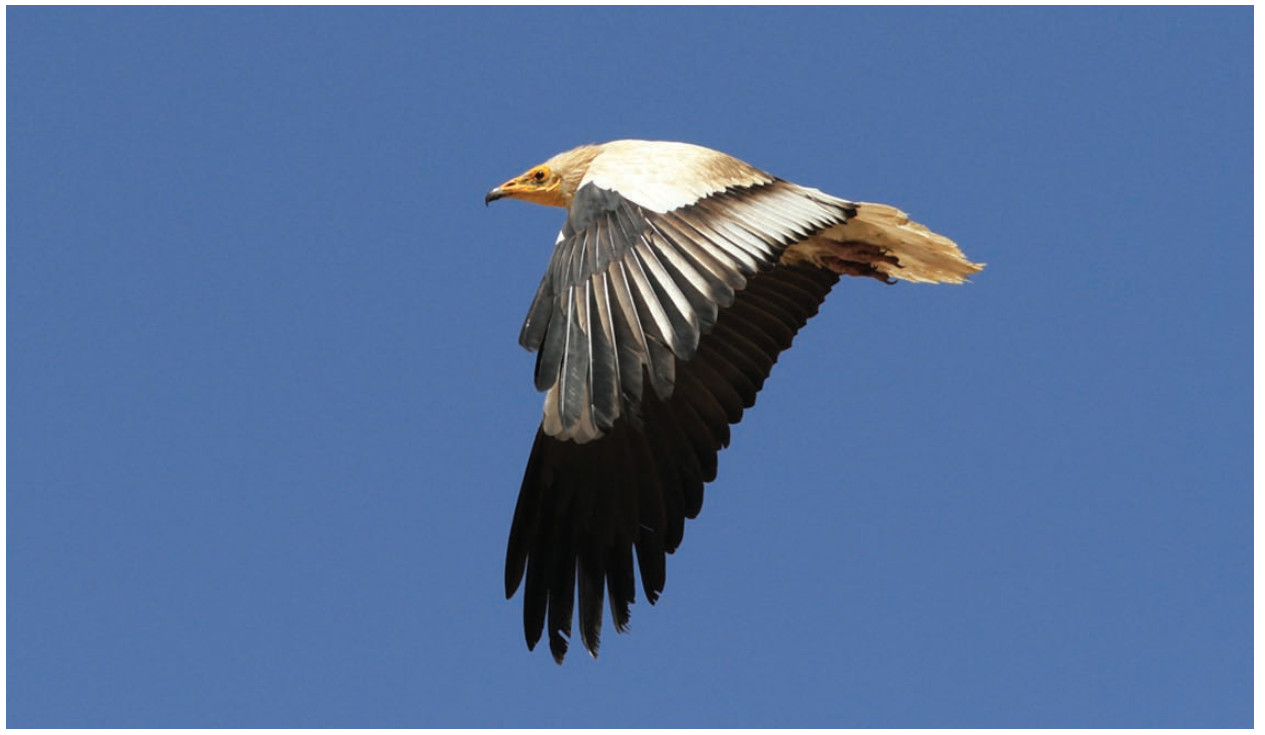
| Citation: | Hong GUO, Ming MA. 2012: The Egyptian Vulture (Neophron percnopterus): record of a new bird in China. Avian Research, 3(3): 238-239. DOI: 10.5122/cbirds.2012.0031 |
In 2 April 2012 a birdwatcher, Mr. Hong Guo, found a strange white bird near a garbage dump in Wuqia County, (39°55′N, 75°15′E), at an elevation of 2100 m. This location is approximately 80 km west of Kaxgar. After experts checked the photographs, it was identified as an adult Egyptian Vulture (Neophron percnopterus), also known as the White Vulture (Fig. 1). This is the first time a Chinese bird-watcher photographed this vulture.
The point of record, Wuqia County, is about 110–130 km distance from the border of Kyrgyzstan and Tajikistan. The Egyptian Vulture is found in southwestern Europe, northern Africa, south and west Asia, as well as some countries neighboring China, i.e., India, Nepal, Pakistan, Afghanistan, Tajikistan, Kyrgyzstan and Kazakhstan. This bird likes to live in groups and use old nests. This species is genetically relatively close to the Bearded Vulture or Lammergeier (Gypaetus barbatus).
The Egyptian Vulture is a medium to large bird (length 56–64 cm); its entire body is white but its flight feathers are black, it has a small head with a narrow and long bill and a wedge-shaped tail (Fig. 2). They sometimes crack eggs by using a stone, a rare example in the case raptors of knowing how to use tools.
Actually, this was not the first record in Xinjiang. About eleven years ago in the Ili River Region (43°37′N, 82°25′E), Jesper Hornskov reported a bird watching record of this species (Hornskov, unpublished; Ma, 2001). However, it was reported as an observation but no photograph is available of the event and therefore no proof of its occurrence at the time. Apparently, this is then the first record for China for this bird (not listed by Cheng, 1987, 2000; Ma, 1995; Yan et al., 1995; MacKinnon et al., 2000; Zheng, 2011), although de Schauensee (1984) noted that "[the species] possibly occurs in W Sinkiang in the Tien Shan region." Flint et al. (1984) listed the species in Kazakhstan and mapped it as occurring right up to the Xinjiang border at about 45°N. Mr. Hong Guo took about 40 clear photos of the event, providing strong evidence of a new record for Chinese birds. It is initially identified as the subspecies Neophron percnopterus percnopterus (Fig. 2).
The program is supported by the National Natural Science Foundation of China (No. 30970340, 31272291).
|
Cheng TH. 1987. A Synopsis of the Avifauna of China. Science Press, Beijing.
|
|
Cheng TH. 2000. A Complete Checklist of Species and Subspecies of the Chinese Birds. Science Press, Beijing.
|
|
de Schauensee RM. 1984. The Birds of China. Smithsonian Institute Press, Washington DC.
|
|
Flint VE, Boehme RL, Kostin YV, Kuznetsov AA. 1984. A Field Guide to the Birds of the USSR. Princeton, New Jersey.
|
|
Ma M. 2001. A checklist of the birds in Xinjiang, China. Arid Zone Res, 18(Suppl. ): 1–90. (in Chinese)
|
|
Ma M. 1995. Birds of Xinjiang. Jeson Consultant Press, Taipei.
|
|
MacKinnon J, Phillipps K, He FQ. 2000. A Field Guide to the Birds of China. Oxford University Press, New York.
|
|
Yan ZW, Zhao ZJ, Zheng GM, Xu WS, Tan YK. 1995. A Field Guide to the Birds of China. Cuiniao Culture Press, Taipei. (in Chinese)
|
|
Zheng GM. 2011. A Checklist on the Classification and Distribution of the Birds of China. Science Press, Beijing.
|